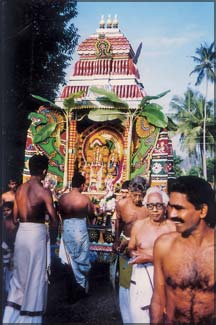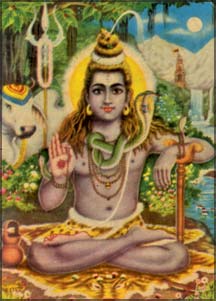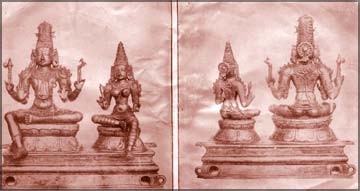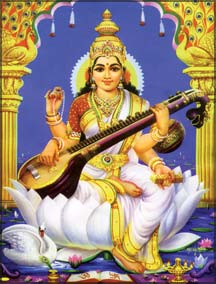Hinduism
The worship of Muruka or Skanda - Part III
Continued from Sept 12, 2009
Goddess Uma has many names: the tamil Pingala Nigantu gives 37.Some
of them are derived from the incidents I have mentioned: Agni-bhu,
fire-born, from the manner of his birth; Gangaja or Gangesa from the
association with the Ganges, (Tam. Kankesan, which gives the name to one
of our Northern ports, Kankesanturai, where his sacred image is said to
have been landed in the 9th century); Saravana Bhava, born in Saravana,
a Himalayana Lake (Tam. Saravanamuttu, pearl of Saravana); Karthikeya
from his foster-mothers Krithikas (the Pleiades); Skanda, the united
one, because the six babes became united into one.
|

A festival |
The more probable derivation is from the root Skand, to leap. Skanda
would them mean the Leaper of his foes. He is also called Shanmukha
(Tam. Sammukam or Arumukam) as being six faced.
Six faced
It is as such that he is adored at Kataragama, no image, form or
symbol being used. Kataragama thus holds a unique place among his
numerous places of worship in India and Ceylon.
The worship of Skanda has suffered no decline in Ceylon from the
introduction of Buddhism 24 centuries ago. The "Kataragama god" (Kataragama
Deyyo) has a shrine in every Buddhist place of worship, and plays a
prominent part in its ceremonials and processions.
In the great annual perahera of Kandy, he had always a leading place'
Buddha's Tooth, now the chief feature of the procession, formed no part
of it till the middle of the 18th century, when it was introduced by
order of King Kirtti Sri Rajasinha to humour the Buddhist monks he had
imported from Siam.
The town of Kalutara on the Southern bank of the Kaluganga appears to
have been specially associated with the God and still retains the name
Velapura, "the city of the Lancer", the lance being his favourite
weapon.
The opposite bank of the town is called Desetra Kalutara, i.e. Deva
Satru or the enemies of the Gods. These names are perhaps relics of an
unsuccessful movement to limit his jurisdiction to the Southern half of
the Island, the defeated opponents being pilloried by his votaries as
demons. His shrines, however, are now as common North as South of the
river: both among Buddhists and Hindus he is the God par excellence.
Intervention
King Dutugemunu in the first century B.C. according to ancient
tradition, rebuilt and richly endowed the Temple at Kataragama as a
thank-offering for the favour of the god, which enabled him to march
from this district against the Tamil King, Elala, and after killing him
in battle, recover the ancestral therone of Anuradhapura.
|

God Skanda |
Dutugemunu's great-great-grandfather Mahanaga, younger brother of
Devanampiya Tissa, had taken refuge in the Southern Province and founded
a dynasty their, and Anuradhapura was for 78 years (with a short break)
ruled by Tamil Kings, of whom Elala (205-161 B.C.) was the greatest.
Dutugemunu conceived the idea of liberating the country from Elala.
While his thoughts were intent on this design day and night, he was
warned in a dream not to embark on the enterprise against his father's
positive injunctions, unless he first secured the aid of the Kataragama
God.
He therefore made pilgrimage thither and underwent severe penances on
the banks of the river, imploring divine intervention. While thus
engaged in prayer and meditation, an ascetic suddenly appeared before
him, inspiring such awe that the prince fainted. On recovering
consciousness, he saw before him the great God of war who presented him
with weapons and assured him of victory. The prince made a vow that he
would rebuild and endow the temple on his return, and started on his
expedition, which ended in the defeat and death of Elala and the
recovery of the therone.
Vow
Stanzas 41 and 46 show that King Dutugemunu invoked the aid of the
God, and received his help and built and endowed the Temple at
Kataragama in fulfilment of his vow. The royal endowment was continued
and enlarged by his successors and by the offerings of generations of
the people and princes of Ceylon.
Woeful plight
This old and once wealthy foundation has for years been in a woeful
plight, from loss of the State patronage and supervision which it
enjoyed under native rule and owing to the corruption and dishonesty of
the Sinhalese trustees and priests in whom, under the Buddhist
Temporalities Ordinance, its adminstration is vested.
Its extensive estates have mostly passed into other hands, the
property that remains in neglected, the Temple buildings are in
disrepair, and the daily services are precarious. The Hindu pilgrims,
however, continue to flock in thousands, pouring their offerings without
stint and wistfully looking forward to the day which will see the end of
the scandalous administration.
It is possible now to travel from Colombo comfortably by train to
Matara and by motor to Hambantota and Tissamaharama.
The last stage of about II miles beyond Tissamaharama is over a
difficult forest-track and an unbridged river, the Menik ganga, which in
flood time has to be swum across there being no boats.
In the thirties of last century, when good roads were scarce even in
Colombo, my grandmother walked barefoot the whole way to Kataragama and
back in fulfilment of a vow for the recovery from illness of her child,
the future Sir Mutu Coomara Swamy.
Spiritual experiences
The hardships then endured are such as are yearly borne with
cheerfulness by thousands travelling on foot along the jungle tracks of
the Northern, Eastern, Eastern and Uva provinces and from India. Nearly
all are convinced of the God's ever-present grace and protection and
have spiritual experiences to tell or other notable boons, recoveries
from illness, help under trials and dangers, warding off of calamities.
I once asked an elderly woman who had journeyed alone through the
forest for days and nights is she had no fear of wild elephants and
bears. She said she saw many, but none molested her. "How could they?
The Lord was at my side".
Source: Studies and
Translations - Philosophical and Religious.
Saivaism in Hinduism - Part V
Continued from Sept 11
S. Sivapadasunderam
Though He loves us all in the same way we do not love Him with equal
intensity. The Shivagamas have graded our love for God into
servant-love, son-love, friend-love and identity-love and have
prescribed different forms of worship to these four grades. These are
respectively Charya, Kiriya, Yoga and Gnana.
|

God Siva |
The Charya form of worship consists in rendering bodily service in
temples, service to devotees and poojah to anyone of the well-defined
images as those of Maheswara, Vinayaka and Subrahmania. In the Kiriya
grade the love is manifested in poojah to the Shiva Lingam. Those in the
Charaya grade can also worship the Shiva Lingam but cannot perform the
poojah. Whereas in the first grade there is more exercise to the body
than to the mind and in the second grade more to the mind than to the
body, worship in the Yoga grade is purely mental. In these three grades
the worshipper identifies himself with God and finally becomes one with
Him, which is the ultimate goal.
Inconsistent
There is another form of our approach to God which can hardly be
called worship. In this form importance is attached to the body and to
things concerned with the body. Thoughts of personal welfare, of the
welfare of wife and children, of wealth, position, ambition etc, fill
the heart of the worshipper who prays for these. These thoughts are
inconsistent with worship.
They cannot co-exist with the thought of God. Such consideration can
find no place in the presence of God.
These are functions of Anava and it must be our sincere endeavour to
belittle these as much as possible. Besides, we have ample time to pay
attention to these all the time we do not worship and we may think of
these if we wish.
If we spend an hour a day in worship we can devote to these the
remaining fifteen hours during which we are awake.
God's reaction
Some of these we get as the result of past Karma, some others by hard
work and others we may never get. Worship has nothing to do with these
things. We derive only what our Karma entitles us to.
|

God Siva and his consorts |
We shall not attain any good for the merely asking God for it. If we
could, the Law of Karma would fall to the ground, and with it our
religion too. Everyone who begs for favour from God gets only a few of
those he begs from God. These reach him as Karmic effects. These he
would have got even without begging for them. Everyday we get endless
things without asking God for them. Atheists evidently get a great many
of the things they wish to have without any appeal to God. It is thus
waste of breath to beg favour from God. Cases are mentioned in our
Puranas of men who performed penances and got from God worldly ends
which are only wages Markandeyar's life is said to have been prolonged
as his wages for his poojah.
Places of worship
The home and the temple are the usual places of worship. To a
religious man, any place is good enough for worship. Such a man has
said, "Think of the Feet of Shiva at all times whether sitting or
standing, lying or walking." With most people, worship at home is short
and simple. Immediately after wash they devote a few minutes to worship.
Some sing a few sacred songs. Some others repeat a mantram a hundred
times with their minds fixed on God. Some others perform Sandhya
Vandanam which includes the above two items also. A few perform poojah
which is a long from of worship. Just before each meal, most people have
a short from of worship. A common practice is to wash the face and hands
and to wear Thiru-Neeru with a few repetitions of some mantram. A good
many contemplate God in going to bed and on rising from bed.
In the temple, the mind gets most attuned to worship during the
poojah which is attended by elevating associations. The temple is
equipped with everything necessary for worship and is as superior to the
home in the facilities for worship as a school is to a home in the
conveniences for study.
The unique value of temple worship is recognised not only by the
Shaiva religion but by every other religion also. Protestant Christians
who use only an empty hall as their place of worship regard it as
indispensable to their religious life.
Late Sri Lal Sri S. Shivapadasunderam was born in a family of Tamil,
Sanskrit, and Shaiva scholars at Puloly, Vadamarachchi. To be continued
Tracing the origin of Saivaism
K. S. Sivakumaran
The purpose of this article is to inform non-Hindu readers some
aspects of Hinduism. Saivaism is one of the components of Hinduism. Lord
Siva or Siva as the (North Indians pronounce) is the primary God of
followers of Saivaism.
To know more about the subject we must go to authorities and scholars
for authentic explanation. One such scholar is Professor Emeritus V.
Sivasamy. But his article is in Thamil. Drawing from his interpretation,
I venture to give the essence of his elucidation in English for our
readers.
Indus valley Civilization
The article appears in a volume titled "Bhakthi Neriyum Panpattu
Koalangalum" The Bhakthi Cult and the Cultural Patterns) published by
the Hindu Cultural Affairs Department nod compiled by K. Irahuparan
(Senior Lecturer in Linguistics at the South Eastern University.
The origin of Saivaism can be traced to the Indus valley Civilization
(B.C. 2500 -1500). But one could gather some ideas evolving in some ways
prior to the IVC (Indus valley Civilization) Statues and Lingams were
found earlier.
During the Vedic times that followed IVC worship of Siva was evident.
The Vedas, Agamas written in Sanskrit were the sources. In Rig Veda Siva
is referred to as Rudra.
Worshipping
Namachivaya meaning worshipping Siva is also mentioned among the
names attributed to lord Siva. Some of these names are Sivadhara,
Shankara, Neelakanda, Pasupathy, Sambu, Girisa and the like.
Among the Ithikasas (Histories) both Ramayana and Mahabharata mention
Saivaism ideas. There are more details of Saivaism in Mahabharata.
Saivaism is dealt with before and after the Sangam Period (B.C. 300 - 30
A.D.) Even in Silapadikaram and Manimekalai, the two great epics in
Thamil mention is made of Saivaism.
Agamas remain the fundamental works that elucidates the Siddantha
Saivaism. Among the Agamas there are two kind of Saivaism mentioned -
Kashmira Saiva Agamas and Saiva Sidantha Agamas.
There are 28 Saiva Agamas, it is believed.
It is also assumed that the Agamas were written during B.C. 6th
century and 7th century B.C. But what would be more reliable is that
these were written during 6th and 9th century A.D.
During the Pallava - Pandiya rule (approximately 550 to 850 A.D) the
Bhakthi Effluence resulted in the flourishing of Saivaism and
Vaishnavism. Lankan scholars of calibre of Thirunelveli Gnanapragasar,
Arumuga Naavalar, Kasivasi Senthinatha Iyer, K. Sivapathasundaram,
Achuvely Kumarasamy Kurukkal, Dr of Literature Pundit m. Kanthiah have
elucidated the Veda Agamas to lay readers.
There are a few books in English that has reference to Siva and
Saivaism. Origin and Early History of Saivaism in South India by C. V.
Narayana Ayyar, Thamil literature and Indian Philosophy by Dr. N.
Kandaswamy to mention two works.
Humankind
In Lanka most of the Hindus are Saivaites they worship Siva, Vishnu,
Pillayaar, Murugan, Paarvathi, Saraswathi, Lakshmi and other minor
deities.
I think as Lankans without any barrier should know about Buddhism,
Hinduism, Christianity and Islam and other religions to think and act as
also part of the total humankind.
Navarathri or Saraswathy Pooja -A period for prayers
Chelvatamby Maniccavasagar
Navarathri Fasting or Sakthi Worship or Saraswathy Pooja in honour of
the Hindu pantheon of Goddesses namely Durgai, Lakshmi and Saraswathy is
celebrated for Nine days commencing from 19th September.
|

Goddess Saraswathy |
In Hinduism the Supreme Lord is represented by Maheswara and His
power is represented by His consort Sakthi. Just as the husband and wife
take care of the family Shiva and Sakthi look after the affairs of the
Universe. Sakthi is the embodiment of power. She is the supreme power by
which the world is made to function. As such, Navarathri is also called
Sakthi Worship.
In one of the poems T.S. Elliot has described the predicament of man
who with all the progress and success he had made in science and
technology finds that endless inventions and endless experiments bring
us knowledge of motion, but not of stillness, knowledge of words and not
of the word.
Lord Shiva without Sakthi is all stillness. It is Sakthi which stirs
in Him the motion and the speech. Shiva is the word, it is Sakthi which
moves to words.
The Union between them is represented by the image of Shiva is Ardha
Nariswara, half man and half woman. Sakthi herself takes different
forms.
Sometimes, she is stern and formidable. Of the many Gods in Hindu
Pantheon none is revered more than Mother Goddess.
Infact, Navarathri is a period of prayers and meditation for moral,
spiritual and material uplift culminating in cultural festivities.
Goodness, prosperity, knowledge are the three aspects of Navarathri
Pooja. Goodness reveals love, while prosperity brings happiness through
selfless service and finally knowledge leads the way to truth and God
realisation.
In the Navarathri pooja, the glorious mother in her aspect as Durgai
is worshipped for three nights in order to eliminate the evil nature in
man.
The next three nights are dedicated to Mother Divine in her aspect as
Maha Lakshmi. The worship of Maha Lakshmi is meant for spiritual and
material welfare. Maha Lakshmi is portrayed as a red lotus draped in a
red saree. She is the protective and sustaining power of Lord Vishnu and
the Goddess of Wealth. She blesses her true and sincere devotees. During
the final three nights the mother in his aspect as Goddess Saraswathy is
worshipped by devotees.
She is the creative power of God Brahma and worshipped as Goddess of
Learning and Wisdom.
Goddess Saraswathy is depicted seated as a white lotus draped in a
white saree playing the Veena indicating that she sings the melody of
life inviting devotees to merge into the Naatha Brahma. Goddess
Saraswathi's appearance symbolises purity and perfection. In fact on the
10th day. (ie) Vijayadasami, special and Colourful rituals are observed
in temples where the battle between Durgai and the Demon is re-enacted.
This ritual is referred as "Maanambu".
Life is a constant battle, a war between good and evil, light and
darkness, knowledge and ignorance, truth and falsehood, immortality and
death.
Undoubtedly, to a world lost in error and beset by illusions of time,
weighed down by conflicts and contradictions, trials and tribulations
Navarathri Vizha or Sakthi worshipping or Saraswathy Pooja will bring
about peace, happiness, harmony, amity, sanity and prosperity in one's
life. |



